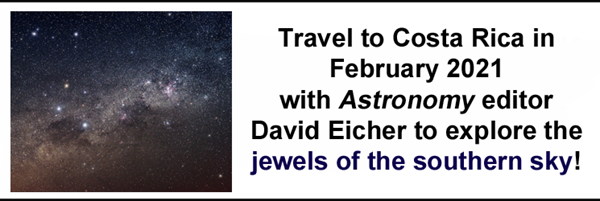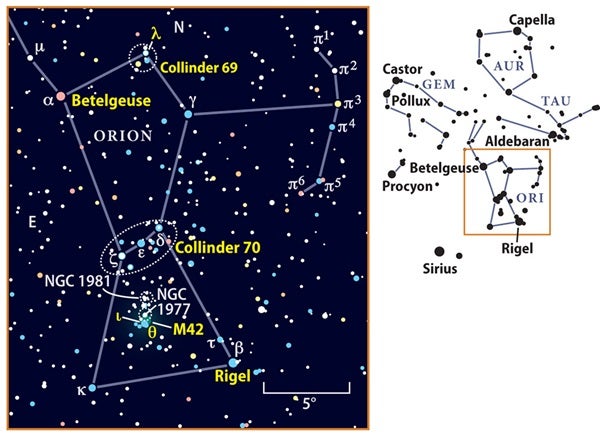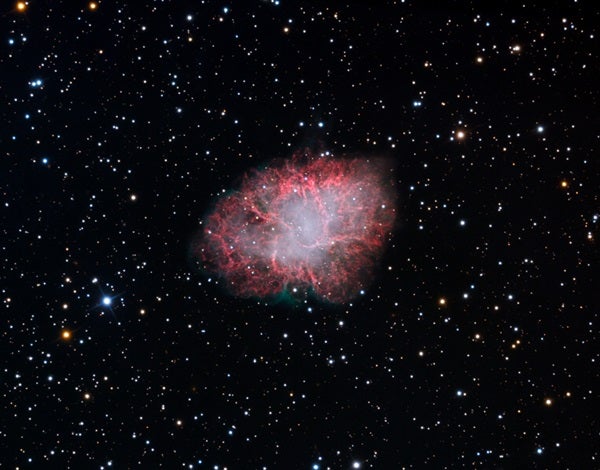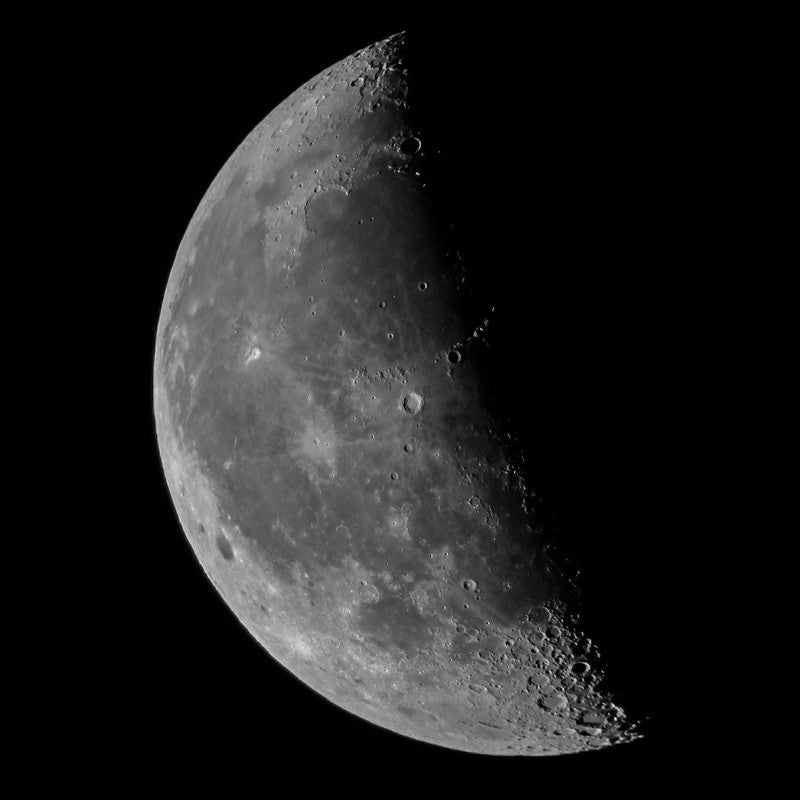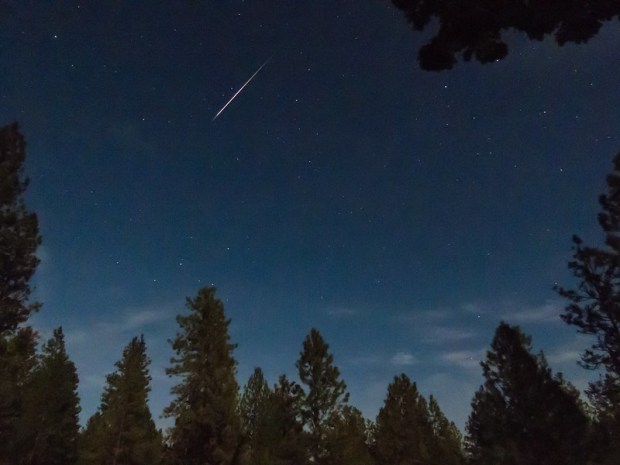Mercury stands still against the background stars at 9 P.M. EST tonight. Before today, it was tracking northeast; it will now begin sliding in the opposite direction, heading southwest. The solar system’s smallest planet is 14° high in the west at sunset. As darkness falls, you’ll see it’s matched in height by Sadalsuud (Beta [β] Aquarii) to the northwest. Observers will have a little over an hour to catch the planet’s 8″-wide disk, which appears 28 percent lit through a telescope, before it sets.
Once Mercury is gone, you can still spot Neptune, about 1.8° northeast of 4th-magnitude Phi (φ) Aquarii. The ice giant is nearly magnitude 8, making it a good binocular or telescope target. Its disk spans just 2″, so even through optics it will appear as a “flat,” bluish star with no discernible features. It will set around 8 P.M. local time.
Sunrise*: 7:11 A.M.
Sunset: 5:16 P.M.
Moonrise: 6:20 P.M.
Moonset: 8:05 A.M.
Moon Phase: Waning gibbous (99%)
*Times for sunrise, sunset, moonrise, and moonset are given in local time from 40° N 90° W. The Moon’s illumination is given at 12 P.M. local time from the same location.
At least half the stars in the sky have one or more stellar companions. That makes multiple-star systems, which are great observing targets, plentiful and easy to find. One of the best is Beta Monocerotis, located in Monoceros the Unicorn. Rising just southwest of Canis Minor at sunset, give this region an hour or two to climb a bit higher in the sky. Then search out magnitude 3.8 Beta, which lies roughly halfway on an invisible line drawn between brighter, easy-to-find Betelgeuse in Orion and Sirius in Canis Major.
Although it appears as a single magnitude 3.8 star to the unaided eye, Beta is a triple-star system with magnitudes 4.6, 5.4, and 5.6. Their light combines to create the “single” star you see without optical aid. The three components, labeled A, B, and C from west to east, are fairly close: B and C are a mere 3″ apart, while A stands apart from the pair by about 7″. Based on this configuration, astronomers believe B and C orbit a common center of mass, while A orbits the pair. A small (4-inch) telescope with 100x magnification will have no problem showing you this gorgeous triple system.
Sunrise: 7:10 A.M.
Sunset: 5:17 P.M.
Moonrise: 7:31 P.M.
Moonset: 8:40 A.M.
Moon Phase: Waning gibbous (95%)
Sunday, January 31
Mars finishes out the month of January high in the southwestern sky as darkness falls. You’ll find it in the constellation Aries, shining brightly at magnitude 0.4 — far brighter than Hamal, Aries’ magnitude 2 alpha star. Mars is currently about 1.2 astronomical units (or AU, where 1 AU is the average Earth-Sun distance) from Earth and appears 8″ wide in the sky. By the end of next month, it will have retreated to nearly 1.5 AU away, losing 2″ of width in the process.
About 6° to Mars’ southwest is Uranus. Glowing at magnitude 5.8, it’s just barely at the edge of naked-eye visibility under dark skies, but easy to identify with binoculars or any small scope. Because it’s farther from Earth than Mars, Uranus appears to move much more slowly than the Red Planet against the background stars and will remain roughly in the same spot in Aries long after Mars has moved into neighboring Taurus later next month.
Sunrise: 7:09 A.M.
Sunset: 5:19 P.M.
Moonrise: 8:41 P.M.
Moonset: 9:11 A.M.
Moon Phase: Waning gibbous (89%)
The American Association of Variable Star Observers (AAVSO) is teaming up with the International Planetarium Society and Ball State University to feature a new variable star each month. There are many kinds of variable stars, which change brightness over time. How long it takes brightness changes to occur depends depending on the underlying mechanism for variability. Studying these stars allows astronomers to better understand how stars form and evolve, while variable stars can also serve as extremely accurate distance indicators to faraway objects, including other galaxies.
February’s variable star is Betelgeuse (Alpha [α] Orionis), that well-known yellow-orange luminary that serves as one of Orion the Hunter’s shoulders. (If you assume the constellation is facing us, it’s his right shoulder.) This red giant star is much larger and older than the Sun, and will someday end its life in a brilliant supernova explosion. But for now, it’s a variable star that changes its brightness by about 3x over the course of 11 months. Over time, compare Betelgeuse’s brightness to nearby stars such as Bellatrix (Gamma [γ] Orionis, magnitude 1.6), Rigel (magnitude 0.2), or even Aldebaran (magnitude 0.9), the red giant eye of Taurus the Bull. Early last year, Betelgeuse was roughly the same brightness of Bellatrix. Take some time tonight and see which star it best matches now. Then, come back over the next few months and watch its brightness evolve.
Once you’ve gotten into the swing of things, consider submitting your data to the AAVSO’s International Database to help astronomers learn more about this fascinating star!
Sunrise: 7:08 A.M.
Sunset: 5:20 P.M.
Moonrise: 9:52 P.M.
Moonset: 9:40 A.M.
Moon Phase: Waning gibbous (82%)
Tuesday, February 2
Asteroid 18 Melpomene is at opposition at 2 A.M. EST. At that time, however, a bright Moon is relatively nearby, making the best time to spot this small magnitude 9.5 world after sunset but before moonrise this evening.
Melpomene lies in the southern region of Cancer the Crab. You’ll find it a mere 30′ northwest of Acubens, Cancer’s alpha star. But tonight, there’s a two-for-one deal on asteroids: 60 Echo is also nearby, glowing a fainter magnitude 10 about 1° south-southwest of Melpomene. And just 1° to the asteroids’ west is M67, a beautiful open star cluster that glows a brighter magnitude 6. It’s sometimes called the King Cobra Cluster.
Melpomene and Echo will continue to travel parallel paths this month, so make sure to return throughout February to track their progress through the realm of the Crab.
Sunrise: 7:07 A.M.
Sunset: 5:21 P.M.
Moonrise: 11:03 P.M.
Moonset: 10: 08 A.M.
Moon Phase: Waning gibbous (72%)
The Moon reaches perigee — the closest point to Earth in its orbit — at 2:03 P.M. EST, when it will sit a mere 229,980 miles (370,117 kilometers) from our planet.
However, the Moon doesn’t rise until after just after midnight tomorrow morning, leaving the evening skies Moon-free for deep-sky observing. Tonight, start with No. 1 in Charles Messier’s catalog: the Crab Nebula (M1). Located just off the tip of one of Taurus’ horns, you’ll find it 1.1° northwest of magnitude 3 Alheka (Zeta [ζ] Tauri). This magnitude 8 nebula is a supernova remnant — a cloud of debris left behind after the explosive death of a massive star. The blast was seen on Earth in the year 1054 A.D. At its very center is the Crab pulsar, a rapidly rotating neutron star formed from the core of the progenitor star. The Crab Nebula stretches 6′ by 4′ and typically appears as a faint gray “smudge” in most telescopes. Its low surface brightness means you need dark skies and calm conditions to really view it well. If you’re an experienced astrophotographer, longer exposures will allow you to bring out some of the cloud’s tangled, twisted detail.
Sunrise: 7:06 A.M.
Sunset: 5:22 P.M.
Moonrise: —
Moonset: 10:08 A.M.
Moon Phase: Waning gibbous (61%)
Thursday, February 4
Last Quarter Moon occurs today at 12:37 P.M. EST.
Today is also the late astronomer Clyde Tombaugh’s 115th birthday. Tombaugh is perhaps most famous for his discovery of Pluto on February 18, 1930. The tiny world, now classified as a dwarf planet, leads a long line of major planets in the morning sky. Dedicated observers can catch Pluto about 30 minutes before sunrise, roughly 4° high (and rising) in the east. But at magnitude 14, it will be an extremely challenging target in the quickly brightening sky, within reach of only large telescopes or long-exposure images.
As the minutes until sunrise tick by, you’ll first see Venus (magnitude –3.9) and then Saturn (magnitude 0.6) clear the horizon. Jupiter rises nearly simultaneously beside the Sun, making it invisible in the morning glare. Take care when observing this close to sunrise, as accidentally swinging your optics toward our star can result in serious and permanent eye damage.
Tonight, the staff of Astronomy magazine will take part in a special celebratory Explore Alliance Global Star Party. We will be joined by Alan Stern, David Levy, Abby Bollenbach, and Michael Bakich. This is your chance to learn more about how we produce the magazine you love and our personal science interests, as well as take a closer look at Pluto and its history with some of the world’s leading experts. The event will begin at 7 P.M. CST; you can tune in at ExploreScientific.com/live, which includes links to watch the show via YouTube, Facebook, Twitch, and Twitter.
Sunrise: 7:05 A.M.
Sunset: 5:23 P.M.
Moonrise: 12:04 A.M.
Moonset: 11:07 A.M.
Moon Phase: Last Quarter (50%)
Friday, February 5
Moonless February evenings are the perfect time to look for the dim glow of the zodiacal light. This cone-shaped pillar of light is created when sunlight reflects off dust scattered throughout the plane of our solar system. To find it, you’ll need to start at a dark location with a clear western sky after sunset. Look first for the Milky Way’s glow, high up in Perseus and arcing through Orion, then stretching down toward the southern horizon. The zodiacal light will appear to stem from the western horizon, reaching up through Pisces and ending near Taurus.
These first two weeks are the month’s best for spotting this phenomenon, but its visibility will continue into March and April evenings as well — so don’t be discouraged if conditions aren’t right in your location just yet.
Sunrise: 7:04 A.M.
Sunset: 5:25 P.M.
Moonrise: 1:26 A.M.
Moonset: 11:43 A.M.
Moon Phase: Waning crescent (39%)


